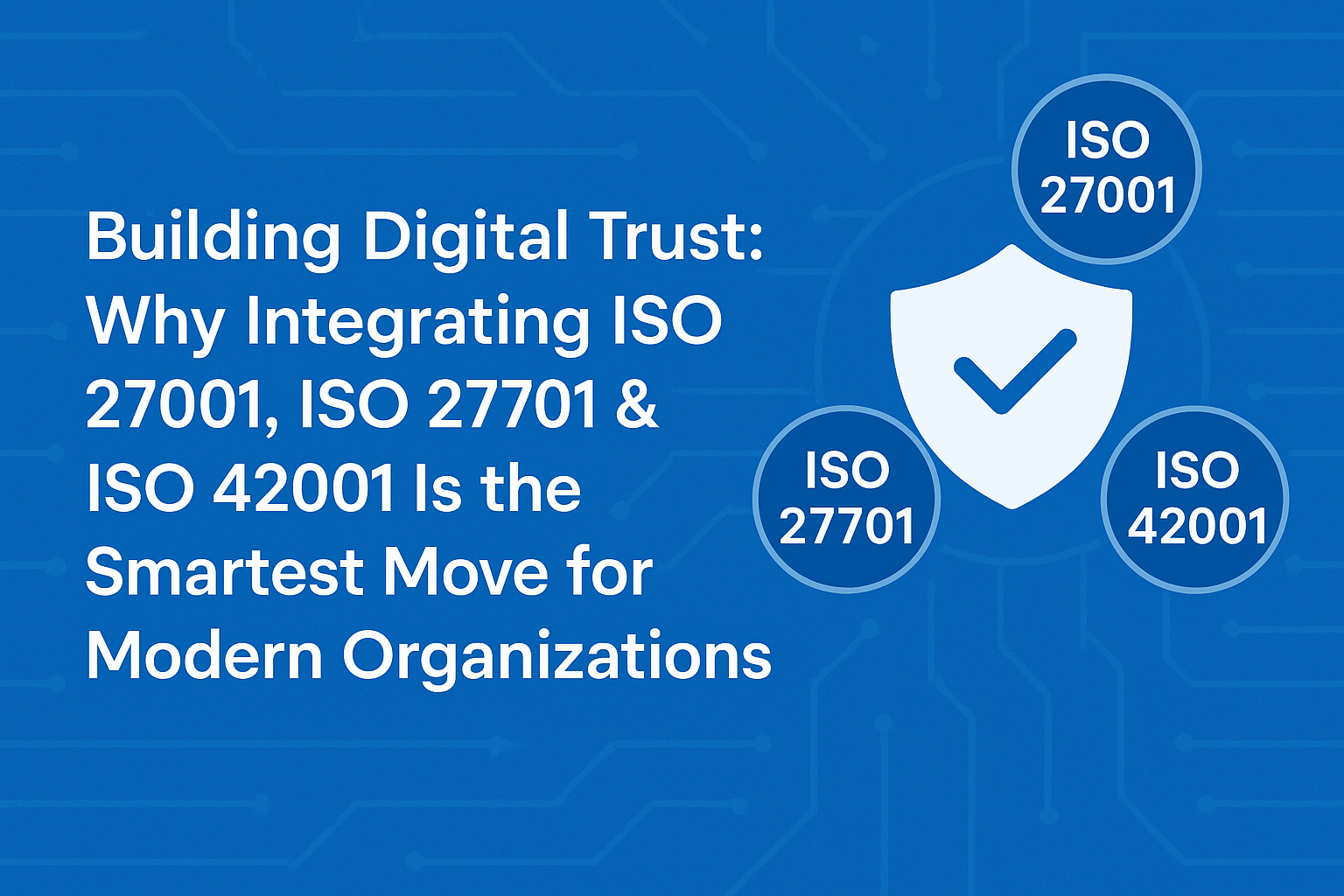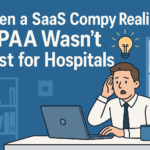The Era of Trust and Technology
We live in a time when data drives every decision and AI shape every experience — from what we buy, to how we work, to how we’re evaluated.
But with all that innovation comes a serious question: Can we trust the systems that handle our information?
Trust is no longer a “nice-to-have.” It’s the foundation of every successful business relationship.
And in the world of data, privacy, and AI, that trust is built through internationally recognized frameworks:
ISO 27001, ISO 27701, and ISO 42001.
Together, they form the ultimate trio for secure, ethical, and transparent data governance.
The Three Standards That Define Digital Responsibility
1️⃣ ISO 27001 — Information Security Management System (ISMS)
Purpose: To protect sensitive data from breaches, misuse, or loss.
ISO 27001 helps you build a strong foundation for information security — the locks, alarms, and guards of your digital world.
It enables you to:
- Identify and classify your data assets.
- Assess risks and design controls.
- Protect information in all forms — paper, cloud, or verbal.
- Continuously monitor and improve your defences.
In Simple Terms:
ISO 27001 is about keeping information safe and secure — it’s the backbone of digital protection.
2️⃣ ISO 27701 — Privacy Information Management System (PIMS)
Purpose: To ensure personal data is handled with care, transparency, and respect.
ISO 27701 extends ISO 27001 to focus on privacy and data protection, aligning with global laws such as GDPR and CCPA.
It helps you:
- Establish a privacy governance framework.
- Manage consent and data subject rights.
- Control how personal data is collected, used, and deleted.
- Demonstrate compliance with privacy regulations.
In Simple Terms:
ISO 27701 adds the human side of information management — protecting not just the data, but the people behind it.
3️⃣ ISO 42001 — Artificial Intelligence Management System (AIMS)
Purpose: To ensure AI is used responsibly, ethically, and transparently.
As AI becomes embedded in business processes, ISO 42001 offers the first global framework for AI governance.
It guides you to:
- Define principles for fairness, transparency, and explainability.
- Identify and mitigate risks in AI development and deployment.
- Monitor models for bias, drift, or ethical issues.
- Build AI systems that align with human values and laws.
In Simple Terms:
ISO 42001 ensures AI remains trustworthy and accountable, not just powerful.
Why Integrating All Three Standards Is a Game-Changer
Integrating ISO 27001, ISO 27701, and ISO 42001 is not just about compliance — it’s about creating a cohesive ecosystem of trust.
Here’s why integration is a strategic advantage:
- Unified Governance
Combine information security, privacy, and AI governance into a single framework.
This eliminates silos, simplifies audits, and ensures consistency across all systems.
- Efficiency and Cost Savings
Shared resources like documentation, risk assessments, and training programs reduce duplication and lower costs.
- Holistic Risk Management
Each standard covers a layer of protection:
- ISO 27001: Secures the data.
- ISO 27701: Protects privacy.
- ISO 42001: Governs AI use.
Together, they close the loop of digital risk.
- Global Credibility and Trust
Certification across all three demonstrates maturity, accountability, and alignment with international best practices — making your organization trusted worldwide.
- Future-Proof Compliance
New regulations around AI and data ethics are coming fast. Integration ensures your organization can adapt smoothly and stay compliant without reworking your entire system.
The Step-by-Step Implementation Roadmap
Here’s how organizations typically and most effectively roll out the integration:
Step 1: ISO 27001 — Secure the Foundation
- Conduct a risk assessment and identify your key information assets.
- Implement controls to safeguard confidentiality, integrity, and availability.
- Develop policies and train your team in security awareness.
Outcome: A strong security management system ready to expand into privacy and AI.
Step 2: ISO 27701 — Add Privacy by Design
- Map personal data flows and define clear handling procedures.
- Build processes for consent, access, correction, and deletion.
- Integrate privacy into your culture and daily operations.
Outcome: Transparent, compliant data practices that earn user trust.
Step 3: ISO 42001 — Govern AI Responsibly
- Identify where AI is used in your operations.
- Define ethical principles and risk assessment frameworks.
- Establish monitoring for fairness, bias, and accountability.
- Document your AI lifecycle — from design to deployment.
Outcome: Responsible and explainable AI that enhances, not endangers, trust.
Step 4: Integration — One System, One Vision
- Align documentation, audits, and governance reviews.
- Merge risk registers and KPIs.
- Use unified reporting and continuous improvement cycles.
- Foster a company-wide culture that values security, privacy, and ethics equally.
Outcome: A single, integrated management system (IMS) that’s efficient, credible, and future-ready.
Real-World Scenario: A Practical Illustration
Picture a healthcare provider using AI to predict patient readmission risks.
- ISO 27001 protects patient data from breaches.
- ISO 27701 ensures the hospital respects consent and privacy.
- ISO 42001 ensures the AI’s predictions are fair, transparent, and explainable.
Together, they create a trustworthy digital healthcare ecosystem — one that improves patient outcomes without sacrificing ethics or security.
Another Real-World Example
Consider a financial institution using AI to detect fraudulent transactions.
- ISO 27001 ensures customer data and systems are secure from hackers.
- ISO 27701 ensures personal data is handled transparently and legally.
- ISO 42001 ensures the AI model doesn’t discriminate or make opaque decisions.
The result? A responsible, transparent, and trustworthy system — one that protects customers and enhances the company’s reputation.
From Compliance to Confidence
Integrating these standards isn’t just a technical exercise — it’s a mindset shift.
It moves your organization from:
- Protection ➜ to Purpose
- Compliance ➜ to Confidence
- Control ➜ to Culture
It’s about proving that technology, privacy, and ethics can coexist harmoniously — and that your organization takes responsibility for doing things right.
Final Thoughts: The Future Belongs to the Trusted
ISO 27001 protects information.
ISO 27701 protects people.
ISO 42001 protects the future.
Together, they create the foundation of digital trust — the most valuable currency in the modern business world.
Organizations that integrate these frameworks aren’t just compliant; they’re visionary. They understand that in the age of AI and data-driven decision-making, trust isn’t just a promise — it’s proof.
Author Tip
Start small — implement ISO 27001 first, then extend. Integration works best when built on real maturity, not rushed checklists. Think evolution, not revolution.

